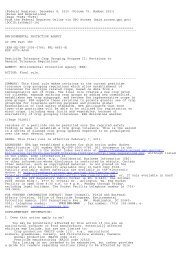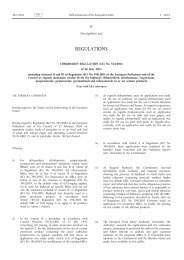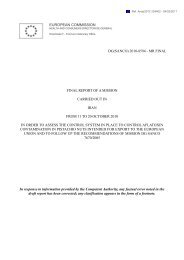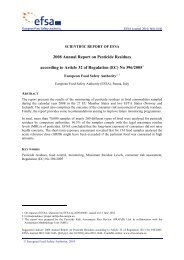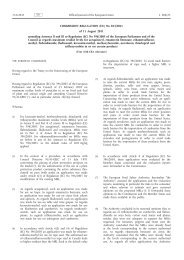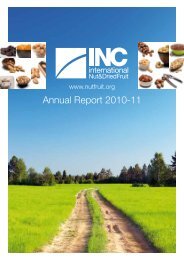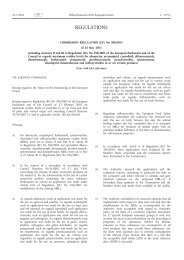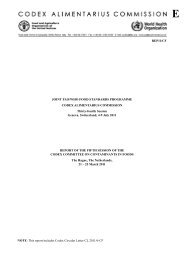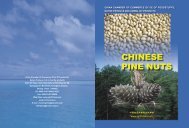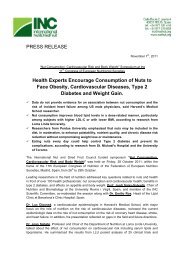final report of a mission carried out in brazil from 15 to 24 march ...
final report of a mission carried out in brazil from 15 to 24 march ...
final report of a mission carried out in brazil from 15 to 24 march ...
Create successful ePaper yourself
Turn your PDF publications into a flip-book with our unique Google optimized e-Paper software.
perform r<strong>out</strong><strong>in</strong>e analyses. Accord<strong>in</strong>g <strong>to</strong> the CGAL, however, it is <strong>in</strong> the <strong>f<strong>in</strong>al</strong> stages <strong>of</strong> submitt<strong>in</strong>g arequest for accreditation <strong>to</strong> standard ISO 17025 by the National Accreditation Body (INMETRO).The <strong>mission</strong> team noted <strong>in</strong> the establishments visited that <strong>in</strong>-house control samples are sent <strong>to</strong> the 2authorised private labora<strong>to</strong>ries <strong>in</strong> São Paulo State and a m<strong>in</strong>imum <strong>of</strong> 8 days are required <strong>to</strong> receiveresults <strong>from</strong> these labora<strong>to</strong>ries.The <strong>mission</strong> team visited the 2 private labora<strong>to</strong>ries.One labora<strong>to</strong>ry is located <strong>in</strong> San<strong>to</strong>s. It focuses on <strong>in</strong>spections and quality certification. Thelabora<strong>to</strong>ry performs chemical analyses for e.g. pesticide residues, GMO and myco<strong>to</strong>x<strong>in</strong>s. Thelabora<strong>to</strong>ry is accredited <strong>to</strong> ISO 17025 by INMETRO. The accreditation certificate was issued on 23September 2008 and is valid until 11 Oc<strong>to</strong>ber 2010. The <strong>mission</strong> team was <strong>in</strong>formed that themethod used for the determ<strong>in</strong>ation <strong>of</strong> afla<strong>to</strong>x<strong>in</strong>s B1, B2, G1, G2 and <strong>to</strong>tal afla<strong>to</strong>x<strong>in</strong>s was validatedfor peanuts, but not yet for Brazil nuts. However, the labora<strong>to</strong>ry stated that a similar procedure wasfollowed for the analysis <strong>of</strong> Brazil nuts. The procedure is <strong>in</strong> full conformity with European standardEN 12955, us<strong>in</strong>g HPLC, Kobra cell and fluorescence detection. LOQ values were around 0.4 μg/kg,well below the limits set <strong>in</strong> Regulation (EC) No 1881/2006. Calibration curves are constructeddaily, recovery is checked daily and samples are run <strong>to</strong>gether with the calibration curve and arecovery check (spiked and blank samples). The labora<strong>to</strong>ry participates <strong>in</strong> the AOCS Labora<strong>to</strong>ryPr<strong>of</strong>iciency Programme for peanut and corn samples, at a frequency <strong>of</strong> 8 times per year, as Brazilnut samples are not available. The expanded measurement uncerta<strong>in</strong>ty is 25 %, calculated accord<strong>in</strong>g<strong>to</strong> the 2000 EURACHEM guide. Confirmation <strong>of</strong> results is based on the uniqueness <strong>of</strong> the immunoassay,the retention time and the use <strong>of</strong> control samples. The recovery, the corrected analytical resultand the expanded measurement uncerta<strong>in</strong>ty are <strong>report</strong>ed.The whole sample is homogenised. Depend<strong>in</strong>g on sample size, an appropriate mill<strong>in</strong>g device isused. Up <strong>to</strong> 3 kg, a meat m<strong>in</strong>c<strong>in</strong>g mill is employed. Above 3 kg, a slurry mixer is used. Accord<strong>in</strong>g <strong>to</strong>the Standard Operat<strong>in</strong>g Procedure (SOP), a m<strong>in</strong>imum amount <strong>of</strong> 3 kg is requested, although an idealsize <strong>of</strong> 10 kg is prescribed. For Brazil nuts, this amount is meant <strong>to</strong> be with<strong>out</strong> shell. All <strong>of</strong> thesample is slurried, with a sample/water ratio <strong>of</strong> 10:<strong>15</strong>. Four samples are taken <strong>from</strong> the slurry, foranalysis, reference and defence purposes. The homogenisation process was tested once with asample. A sample <strong>of</strong> nuts is analysed with<strong>out</strong> shell. If it is delivered with shell, it is unshelled beforeanalysis. The complete unshelled sample is analysed, so with<strong>out</strong> any sort<strong>in</strong>g.The <strong>mission</strong> team visited a second private labora<strong>to</strong>ry <strong>in</strong> Sao Paolo. This labora<strong>to</strong>ry had already beenvisited dur<strong>in</strong>g the first FVO <strong>mission</strong> <strong>to</strong> Brazil concern<strong>in</strong>g Brazil nuts <strong>in</strong> 2003 (SANCO/9027/2003)and the second FVO <strong>mission</strong> <strong>in</strong> 2004 (SANCO/7074/2004). The labora<strong>to</strong>ry was accredited byINMETRO <strong>to</strong> ISO 17025. The accreditation certificate was issued on 25 August 2008 and was validuntil 25 August 2011. The <strong>mission</strong> team was <strong>in</strong>formed that the method used for the determ<strong>in</strong>ation <strong>of</strong>afla<strong>to</strong>x<strong>in</strong>s B1, B2, G1, G2 and <strong>to</strong>tal afla<strong>to</strong>x<strong>in</strong>s was validated for peanuts and validation for Brazilnuts was ongo<strong>in</strong>g. It is a TLC method, <strong>in</strong> conformity with method 970.44 <strong>of</strong> the Official Methods <strong>of</strong>Analysis issued by AOAC International, 18 th edition, 2005. The SOP <strong>report</strong>ed LOQ values <strong>of</strong> 0.5μg/kg for afla<strong>to</strong>x<strong>in</strong>s B1 and G1 and 0.25 for B2 and G2 <strong>in</strong> Brazil nuts, well below the limits set <strong>in</strong>regulation (EC) No 1881/2006.Samples are all dry-milled. Up <strong>to</strong> 3 kg, a meat m<strong>in</strong>c<strong>in</strong>g mill is used, after which furtherhomogenisation is performed us<strong>in</strong>g a Stephan mill. For samples up <strong>to</strong> 30 kg (until now onlyrelevant for peanut samples), portions are first milled <strong>in</strong> a Stephan mill and then transferred <strong>to</strong> acement mixer. When the entire pre-milled sample is <strong>in</strong> the cement mixer, it is homogenised furtherand samples are then taken for analysis, reference and defence purposes. The homogenisationprocess was tested once. A sample <strong>of</strong> nuts is analysed with<strong>out</strong> shell. If it is delivered with shell, it isunshelled before analysis. The complete unshelled sample is analysed, with<strong>out</strong> any prior sort<strong>in</strong>g.Positive samples are re-run on a second TLC plate, <strong>to</strong>gether with calibration standards and a control11



